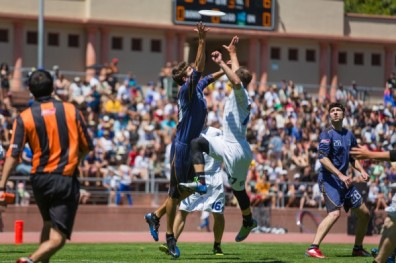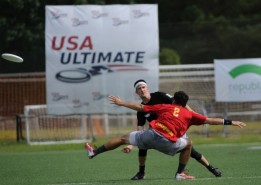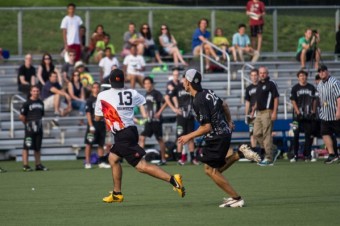In covering sports, media outlets are obsessed with figuring out who is winning, even when games aren’t being played. Aaron Rodgers is injured, how much does this hurt the Green Bay Packers Super Bowl chances? The Brooklyn Nets added Kevin Garnett and Paul Pierce, will they become the most popular team in New York? The Boston Red Sox won three World Series in ten years, are they a dynasty?
In Ultimate we’re just as guilty of this guessing game. Nowhere is it more clear than when reading about the semi pro leagues, their varying successes, and quest for sustainable success. So when discussing the American Ultimate Disc League (AUDL) expansion to 18 teams for the 2014 season, it’s impossible to do it without comparing it to Major League Ultimate (MLU) and the Triple Crown Tour (TCT). The only problem is, the AUDL isn’t playing the MLU or TCT in a game of Ultimate, yet we’re still constantly trying to figure out which one is winning. So we use the incomplete information we have to say which one is going to win.
You’ve probably heard it all before. Something along the lines of “The MLU is way ahead of the AUDL, look at the players they have. Their teams are way better!” Or, “It doesn’t matter what the pro leagues do, USAU ended this discussion when they signed the ESPN deal.” We use what information we have, such as team quality, ESPN appearances, attendance at games, online presence, to measure who’s winning. While that information is useful, it isn’t the complete picture. Particularly with the MLU and AUDL, the fact that we don’t have access to their annual expenses report, and we don’t know whether or not they’re reaching their targets when it comes to attendance, or how much they’re spending to broadcast games online leaves us in the dark. The AUDL understands that those in the Ultimate community see their league as lagging behind the MLU. After all, the MLU does have better players, a stronger web presence, is located in more Ultimate hotbeds, and on average has better attendance than the AUDL.
So what can the AUDL do about this perception gap? The strategy seems to be that instead of trying to beat the MLU, the AUDL is going to continue its plan of growing a coast to coast league, regardless of what the MLU does. That means in 2014 we’ll see new franchises in Seattle, Vancouver, San Francisco, San Jose, Salt Lake City, and Montreal. Then in 2015 the AUDL will expand to the Southeast, with franchises in Atlanta, Jacksonville, a North Carolina team or two, along with other possible locations that are still being worked out. The plan was to have a 25 team league from coast to coast by 2016, and the AUDL isn’t going to let the MLU get in the way. Meanwhile, the MLU has put their expansion plans on hold. While it originally intended to introduce a Midwestern Division in 2014, including Denver, Chicago, Minneapolis/St. Paul, Pittsburgh, and Toronto, the MLU is standing pat at eight teams. Perhaps not coincidentally, Toronto and Chicago both enjoyed success as AUDL teams in 2013, and would make it difficult for new MLU teams there to draw top club talent. While the MLU is focused on improving the product it currently provides, the AUDL is trying to bring its product to more people.
Who’s Ahead?
So the question is, impossible as it is to answer, which is the winning strategy? The closest comparison for the two semi-professional Ultimate leagues is Lacrosse, with the National Lacrosse League (NLL) and Major League Lacrosse. Unlike the MLU and AUDL though, those two league play in different seasons, have significant rules differences, and even though they play in different seasons they still don’t overlap markets. When I spoke with Tim DeByl, the owner of the Madison Radicals, he frequently brought up how the AUDL wasn’t going to worry about what the MLU was doing. But the MLU undoubtedly had an impact on the AUDL in 2013, and will continue to in 2014.

Having the Dogfish and Rainmakers in town will make life difficult for the Seattle Raptors and San Francisco Flamethrowers in 2014 (Photo by Scott Roeder-Ultiphotos.com)
In 2013 there were three cities where the two leagues overlapped, Philadelphia, New York, and DC. That number is doubling in 2014, with the AUDL expanding to Seattle, San Francisco, and Vancouver. The AUDL is not expecting Nighthawks, Rainmakers, or Dogfish players to change their minds and jump ship, but they still feel that it is important for a national Ultimate league to have a presence in those cities. What makes expanding to those cities so difficult isn’t necessarily drawing talent outside of the MLU teams already there, but attracting enough fans to warrant keeping the team around. With the possible exception of the DC Current, each of the six pro Ultimate teams in New York, Philadelphia, and DC had underwhelming attendance numbers. Some of that had to do with less than ideal venue locations, but each franchise was competing for a base of fans with another Ultimate team. The AUDL talks a lot more about drawing fans from outside the Ultimate community than the MLU does, but for a game to seem fun there has to be a solid base of hardcore fans there that are really into the game to begin with. Not only will this problem persist with the new AUDL teams in Seattle, San Francisco, and Vancouver, it will be even more difficult since those MLU franchises already have a one year head start. That’s probably why the MLU wasn’t too eager to start a Midwestern Division that would be competing with three AUDL franchises that are already established.
One thing the AUDL has been criticized for, especially when compared to the MLU, is the relatively lower quality of play. The AUDL isn’t nearly as tied to elite club teams as the MLU. Though that means AUDL teams don’t start off at the same level as MLU teams, the AUDL sees avoiding direct relationships with elite club teams as an advantage. With USAU planning on bringing the TCT into the summer, conflicts between the semi pro leagues and the TCT are only going to increase from here on out.
“One of the key things is to not let the club teams dictate what happens. In Madison I made sure there was a real break between the club team and the Radicals,” DeByl said. “We’re still going to talk a lot about that partnership, but we also don’t want to get too invested because we know USAU sees us as competition. They’re going to move the club series into the AUDL season. We don’t want that to make it impossible for us to operate.”

USAU is only going to move the Triple Crown Tour further into the summer, causing a conflict for both the MLU and AUDL down the line. (Photo by Kevin Leclaire - Ultiphotos.com)
While the AUDL is trying to plan around the TCT, almost all MLU teams (the Philadelphia Spinners being the notable exception) are directly tied to elite men’s club teams. The 2014 season isn’t going to be the main problem, but once the TCT moves into the summer, those club teams are going to be forced to make a choice. The AUDL is trying to avoid that TCT vs. Pro League choice that seems inevitable for the MLU.
Another risk inherent with such quick expansion is that the AUDL may end up letting some owners in that are not prepared to run a team. While the AUDL does have a vetting process, with an increased buy in being one of the main hurdles to owning a team, there is more to owning a franchise than having deep enough pockets to cover travel expenses. AUDL leadership has emphasized the importance of creating a fun atmosphere at games, with entertainment going beyond what’s happening between the cones. While some franchises excelled in this area, particularly Madison, others struggled. If an ownership group fails in one of these cities, it would be the end of the AUDL there. Meanwhile the AUDL’s energies are focused on helping these new franchises, while it still has returning franchises that are by no means economically sustainable. And when I say economically sustainable, I’m not talking about turning a profit. It’s okay for teams not to turn a profit the first few years, as long as the investors are prepared for it, which they seem to be in the AUDL. But you do have to make sure you’re not losing so much money that it seems like you’ll never get a return on your investment. The west coast expansion teams are going to have higher travel expenses than ever before in the AUDL. Since travel expenses were the number one cost for practically every AUDL team, west coast teams will probably be going deeper in the red than their East Coast and Midwestern counterparts. That compounded with the potential MLU competition problem, could mean that we don’t see nearly as many teams return in 2015 as we will in 2014. But the AUDL is confident in their expansion owners, which includes former Toronto Rush owner Rob Lloyd who will be taking over the Vancouver team. Jim Lloyd will be taking over ownership responsibilities for Toronto.
The Expansions
Lost in the shuffle of the new West Coast expansion is the franchise in Montreal.
“We had talked to our players in Toronto, and they really thought Montreal was a great spot. There’s a big Ultimate organization there and they have a good men’s and co-ed club team that sort of work together and both those teams will be represented on the pro team,” DeByl said. “Along with the proximity to Toronto, some of the bigger sponsors in Canada were interested in having more Canadian teams.”
While Montreal owners have said they’ll need to average 1700 fans a game to turn a profit, after their $15,000 purchase they are most likely prepared not to reach that goal in their first year. Montreal will easily become the furthest north team in the AUDL, meaning they will have to travel at least five hours for each of their games, unlike the rest of their Eastern Conference rivals. But the Rush had similar travel hurdles, as most of the teams in the Midwest did last year. Adding Montreal also gives the AUDL a safety net should one of the east coast teams fold. There is a large enough Ultimate community in Monreal to provide a base of fans, and the players are strong enough to reach the AUDL playoffs.
Salt Lake City is the one Western Conference team the AUDL is adding that isn’t within an hour drive of an existing MLU team. It also won’t be within a ten hour drive for any AUDL team either. The AUDL is currently working on how best to keep travel costs down, but with Salt Lake so far separated from the other Western Conference teams, there are some unavoidable realities. They’ll have to fly for away games, presumably playing two games whenever they leave Salt Lake. Other teams will most likely have to fly to them as well. On top of that, the Salt Lake Lions could end up with a few players that don’t play on Sundays. While some have expressed skepticism at the potential quality of a Salt Lake team, the Powderhogs are one of the rare Utah teams that do play on Sundays, a fairly strong team that played Voodoo very close at 2013 Northwest Regionals. Brigham Young University is a high level college team that hasn’t gotten to show it on the national level since they choose not to play Sundays. Likewise The Killjoys are a fairly strong club team that also forgoes playing on Sundays. Salt Lake City management will have to be careful in their player selection process, otherwise they could get consistently blown out in the second game of a two game weekend. Tim DeByl said the Salt Lake franchise speaks to one of the main differences between the MLU and AUDL.
“One of the things we’re doing differently than the MLU is that we want to help build Ultimate audiences. What they’ve done is gone into some of the best cities and used the best club teams to get Ultimate fans at the games,” said DeByl. “We like the idea of going into cities that aren’t on the top Ultimate cities map, and grow the Ultimate audience which will help overall. We don’t think you can build a fanbase via youtube.”
Go Southeast
What the AUDL could have done, rather than prioritizing the West Coast expansion, is moved into the Southeast first instead. While they are planning to move to the Southeast in 2015, moving there before going West would have made more sense. The Southeast would be able to provide elite competition, Ultimate friendly markets, and large metropolitan areas. All of that without any competition from the MLU. A five team division of Jacksonville, Atlanta, Raleigh, Charlotte, and Nashville makes a lot of sense. While part of the problem may be that finding investors on the west coast was easier, the Southeast could have potentially given the AUDL better teams, more fans at games, and lower travel expenses. The longest commute for any team in that division would be between Jacksonville and Nashville, which is eight and a half hours. That becomes even more manageable considering Atlanta is located almost halfway between them.
With that proposed Southeastern Division you’d have players from teams like Ring of Fire, Chain Lightning, Florida United, Cash Crop, and Tanasi competing. Waiting until 2015 for the West Coast expansion would be good too. Just like the AUDL, the MLU is not a proven commodity, and anything could happen after year two. It’s no certainty that players will feel as bound to their MLU teams in 2015 as they do in 2014.
DeByl himself said that “The most important thing over the next three seasons is ticket sales. That’s going to drive franchises success or failure,” over other factors like SportsCenter top ten appearances, youtube views, or website hits. But having success at the gates will be more difficult when they’re not the only game in town. The AUDL has frequently talked about expanding outside the Ultimate fan base, which has been successful in Madison and Toronto. But, each team has to have a starting point for a fan base. And that starting point is always going to be members of the Ultimate community. And establishing that starting point would be so much easier in cities where the MLU doesn’t have a head start.
Grading the AUDL

AUDL franchises in New York and Philadelphia were successful on the field in 2013, but both struggled getting fans to games. (Photo by Sandy Canetti -Ultiphotos.com)
In 2013 the AUDL was graded on a tough curve. It was constantly compared to the MLU and TCT. Really the better comparison would have been the AUDL in 2012. The league leadership, structure, and quality of play has risen leaps and bounds since then. But the 2014 AUDL season provides an even greater challenge than the 2013 season. Last year, getting through the season without any lawsuits, forfeits, or defections to another league made the year successful compared to 2012. In 2014 the AUDL will be expected to make strides again, but this time with a much higher baseline.
The one thing the AUDL is trying to make clear is that they aren’t playing this year by year. They expect a couple of the west coast franchises to struggle initially, but they’re in this for the long haul. They understand that some teams will not thrive initially, and one or two may not make it. The league wants to be on the West Coast because it believes it will help legitimize the league, by establishing teams in the biggest Ultimate hotbeds in the country. But expanding that way makes it more difficult than it needs to be.
The Seattle Raptors, San Francisco Flamethrowers, and Vancouver Riptide all have the potential to be one of the best teams in the AUDL. But regardless of how well they perform on the field, we will probably see those teams struggle to draw fans just like the AUDL franchises in New York, Philadelphia, and Washington DC did in 2013. The AUDL expansion this year is another step in trying to establish a nationwide league. But the league may be biting off more than it can chew in 2014.
Feature photo by Sandy Canetti – Ultiphotos.com








Comments Policy: At Skyd, we value all legitimate contributions to the discussion of ultimate. However, please ensure your input is respectful. Hateful, slanderous, or disrespectful comments will be deleted. For grammatical, factual, and typographic errors, instead of leaving a comment, please e-mail our editors directly at editors [at] skydmagazine.com.